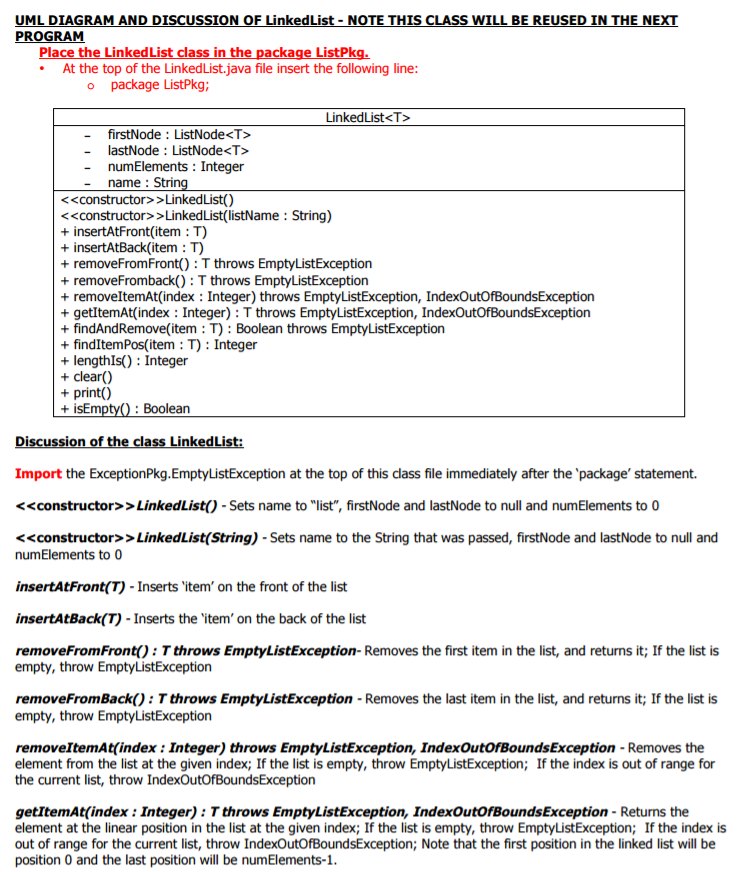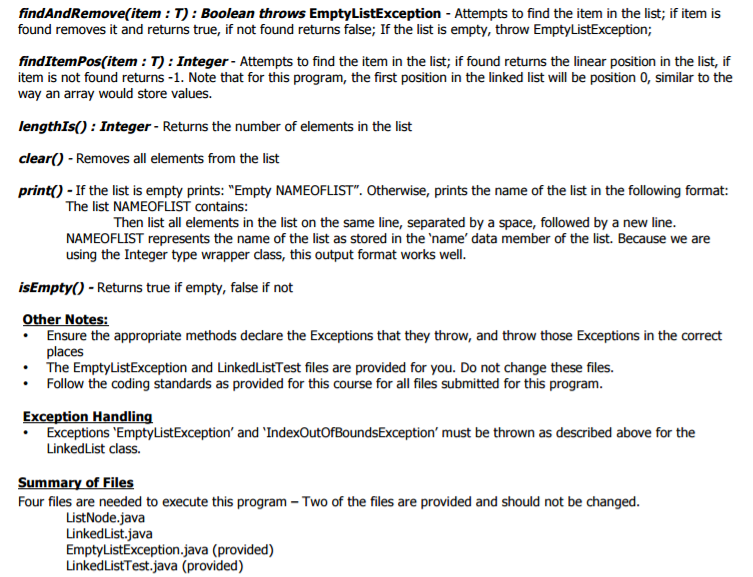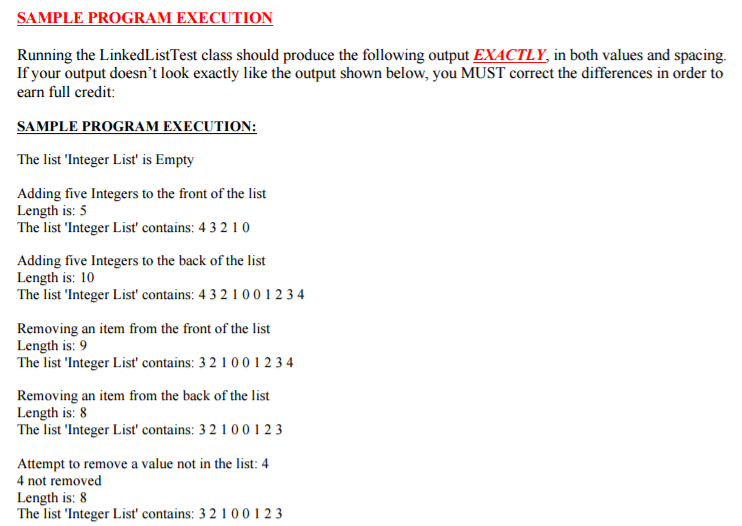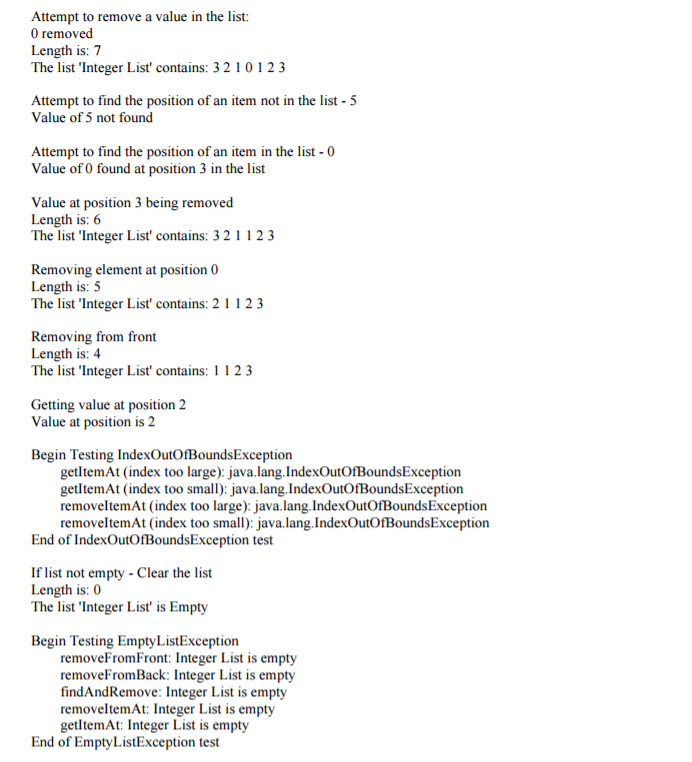Question
I need help with the ListNode java code and the LinkedList code for this java program. The other two files are provided and the code
I need help with the ListNode java code and the LinkedList code for this java program. The other two files are provided and the code listed at the bottom.




 \
\
Code for EmptyListException.java:
// Filename: EmptyListException.java // Defines the Exception - EmptyListException that can be thrown // when an operation is requested that is not supported for an empty list // // This class will be stored in the ExceptionPkg package.
package ExceptionPkg; public class EmptyListException extends RuntimeException { // constructor with no parameter public EmptyListException () { this ("List"); } // constructor with .String. parameter public EmptyListException (String name) { // call super class constructor super (name + " is empty"); } }
------------------------------------------------------------
Code for LinkedListTest.java:
// Filename: LinkedListTest.java
// // This file contains a main method to create an object of type LinkedList and // test all the methods defined for the LinkedList class.
// Import the LinkedList and EmptyListException classes from their appropriate packages import ListPkg.LinkedList; import ExceptionPkg.EmptyListException;
import java.util.Scanner;
public class LinkedListTest { public static void main(String[] args) {
// Create the linked list object 'myList' to hold Integer objects and print the list LinkedList
System.out.println(); myList.print(); System.out.println();
// Add five items to the front of the list and print the list System.out.println("Adding five Integers to the front of the list"); for(int x = 0; x
// Add five items to the back of the list and print the list System.out.println("Adding five Integers to the back of the list"); for(int x = 0; x
// remove an item from the front and from the back of the list // print the list System.out.println("Removing an item from the front of the list"); try { myList.removeFromFront(); } catch(EmptyListException ELE) { System.out.print(ELE.getMessage()); } printLengthAndList(myList); System.out.println("Removing an item from the back of the list"); try { myList.removeFromBack(); } catch(EmptyListException ELE) { System.out.print(ELE.getMessage()); } printLengthAndList(myList);
// Try to remove the Integer value 4 from the list // catch the EmptyListException if thrown // display the list System.out.println ("Attempt to remove a value not in the list: 4"); try { if(myList.findAndRemove(4)) { System.out.println("4 removed"); } else { System.out.println("4 not removed"); } } catch(EmptyListException ELE) { System.out.println(ELE.getMessage()); } printLengthAndList(myList);
// Try to remove the Integer value 0 from the list // catch the EmptyListException if thrown // display the list System.out.println ("Attempt to remove a value in the list: "); try { if(myList.findAndRemove(0)) { System.out.println("0 removed"); } else { System.out.println("0 not removed"); } } catch(EmptyListException ELE) { System.out.println(ELE.getMessage()); } printLengthAndList(myList);
// Try to find position of an item not in the list System.out.println("Attempt to find the position of an item not in the list - 5"); int position = myList.findItemPos(5); if(position!=-1) { System.out.printf("Value of 5 found at %d ", position); } else { System.out.println("Value of 5 not found"); }
// Try to find position of an item in the list System.out.println(" Attempt to find the position of an item in the list - 0"); position = myList.findItemPos(0); if(position!=-1) { System.out.printf("Value of 0 found at position %d in the list ", position); } else { System.out.println("Value of 0 not found"); } // Remove the item at 'position' in the list System.out.printf(" Value at position %d being removed ", position); myList.removeItemAt(position); printLengthAndList(myList);
// Remove the first element in the list - item at position 0 System.out.println("Removing element at position 0"); myList.removeItemAt(0); printLengthAndList(myList);
// Remove the first element in the list - item at the front System.out.println("Removing from front"); myList.removeFromFront(); printLengthAndList(myList);
// get the object at position 2 in the list System.out.println("Getting value at position 2"); Integer temp = myList.getItemAt (2); System.out.printf("Value at position is %d ", temp);
// Test the 'getItemAt' method for the IndexOutOfBoundsException System.out.println(" Begin Testing IndexOutOfBoundsException"); try { myList.getItemAt(4); } catch(IndexOutOfBoundsException IOBE) { System.out.println("\tgetItemAt (index too large): " + IOBE); } try { myList.getItemAt(-1); } catch(IndexOutOfBoundsException IOBE) { System.out.println("\tgetItemAt (index too small): " + IOBE); }
// Test the 'remove' method for the IndexOutOfBoundsException try { myList.removeItemAt(4); } catch(IndexOutOfBoundsException IOBE) { System.out.println("\tremoveItemAt (index too large): " + IOBE); }
try { myList.removeItemAt(-1); } catch(IndexOutOfBoundsException IOBE) { System.out.println("\tremoveItemAt (index too small): " + IOBE); }
System.out.println("End of IndexOutOfBoundsException test ");
// Clear list System.out.println("If list not empty - Clear the list"); if(!myList.isEmpty()) { myList.clear(); } printLengthAndList(myList);
System.out.println(" Begin Testing EmptyListException");
// test removeFromFront, removeFromBack, findAndRemove, removeItemAt and getItemAt with // the empty list try { myList.removeFromFront(); } catch(EmptyListException ELE) { System.out.println("\tremoveFromFront: " + ELE.getMessage()); }
try { myList.removeFromBack(); } catch(EmptyListException ELE) { System.out.println("\tremoveFromBack: " + ELE.getMessage()); }
try { myList.findAndRemove(0); } catch(EmptyListException ELE) { System.out.println("\tfindAndRemove: " + ELE.getMessage()); }
try { myList.removeItemAt(0); } catch(EmptyListException ELE) { System.out.println("\tremoveItemAt: " + ELE.getMessage()); }
try { myList.getItemAt(0); } catch(EmptyListException ELE) { System.out.println("\tgetItemAt: " + ELE.getMessage()); }
System.out.println("End of EmptyListException test "); }
// Method: printLengthAndList (LinkedList
Step by Step Solution
There are 3 Steps involved in it
Step: 1

Get Instant Access to Expert-Tailored Solutions
See step-by-step solutions with expert insights and AI powered tools for academic success
Step: 2

Step: 3

Ace Your Homework with AI
Get the answers you need in no time with our AI-driven, step-by-step assistance
Get Started


